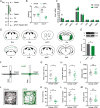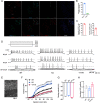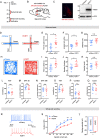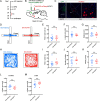The Slack Channel Regulates Anxiety-Like Behaviors via Basolateral Amygdala Glutamatergic Projections to Ventral Hippocampus
- PMID: 35197318
- PMCID: PMC8985866
- DOI: 10.1523/JNEUROSCI.2027-21.2022
The Slack Channel Regulates Anxiety-Like Behaviors via Basolateral Amygdala Glutamatergic Projections to Ventral Hippocampus
Abstract
Anxiety disorders are a series of mental disorders characterized by anxiety and fear, but the molecular basis of these disorders remains unclear. In the present study, we find that the global Slack KO male mice exhibit anxious behaviors, whereas the Slack Y777H male mice manifest anxiolytic behaviors. The expression of Slack channels is rich in basolateral amygdala (BLA) glutamatergic neurons and downregulated in chronic corticosterone-treated mice. In addition, electrophysiological data show enhanced excitability of BLA glutamatergic neurons in the Slack KO mice and decreased excitability of these neurons in the Slack Y777H mice. Furthermore, the Slack channel deletion in BLA glutamatergic neurons is sufficient to result in enhanced avoidance behaviors, whereas Kcnt1 gene expression in the BLA or BLA-ventral hippocampus (vHPC) glutamatergic projections reverses anxious behaviors of the Slack KO mice. Our study identifies the role of the Slack channel in controlling anxious behaviors by decreasing the excitability of BLA-vHPC glutamatergic projections, providing a potential target for anxiolytic therapies.SIGNIFICANCE STATEMENT Anxiety disorders are a series of mental disorders characterized by anxiety and fear, but the molecular basis of these disorders remains unclear. Here, we examined the behaviors of loss- and gain-of-function of Slack channel mice in elevated plus maze and open field tests and found the anxiolytic role of the Slack channel. By altering the Slack channel expression in the specific neuronal circuit, we demonstrated that the Slack channel played its anxiolytic role by decreasing the excitability of BLA-vHPC glutamatergic projections. Our data reveal the role of the Slack channel in the regulation of anxiety, which may provide a potential molecular target for anxiolytic therapies.
Keywords: Slack channel; anxiety; basolateral amygdala; corticosterone; ventral hippocampus.
Copyright © 2022 the authors.
Figures










Similar articles
-
Nos1+ and Nos1- excitatory neurons in the BLA regulate anxiety- and depression-related behaviors oppositely.J Affect Disord. 2023 Jul 15;333:181-192. doi: 10.1016/j.jad.2023.04.049. Epub 2023 Apr 18. J Affect Disord. 2023. PMID: 37080493
-
Anterior Cingulate Cortex and Ventral Hippocampal Inputs to the Basolateral Amygdala Selectively Control Generalized Fear.J Neurosci. 2019 Aug 14;39(33):6526-6539. doi: 10.1523/JNEUROSCI.0810-19.2019. Epub 2019 Jun 17. J Neurosci. 2019. PMID: 31209172 Free PMC article.
-
Involvement of the basolateral amygdaloid nucleus anterior part 5-HT7 receptors in the regulation of anxiety-like behaviors in hemiparkinsonian rats.Exp Neurol. 2025 Jul;389:115239. doi: 10.1016/j.expneurol.2025.115239. Epub 2025 Apr 5. Exp Neurol. 2025. PMID: 40194650
-
Basolateral amygdala, nicotinic cholinergic receptors, and nicotine: Pharmacological effects and addiction in animal models and humans.Eur J Neurosci. 2019 Aug;50(3):2247-2254. doi: 10.1111/ejn.13970. Epub 2018 Aug 31. Eur J Neurosci. 2019. PMID: 29802666 Review.
-
Basolateral amygdala and stress-induced hyperexcitability affect motivated behaviors and addiction.Transl Psychiatry. 2017 Aug 8;7(8):e1194. doi: 10.1038/tp.2017.161. Transl Psychiatry. 2017. PMID: 28786979 Free PMC article. Review.
Cited by
-
Slack K+ channels limit kainic acid-induced seizure severity in mice by modulating neuronal excitability and firing.Commun Biol. 2023 Oct 11;6(1):1029. doi: 10.1038/s42003-023-05387-9. Commun Biol. 2023. PMID: 37821582 Free PMC article.
-
Tonic-clonic seizures induce hypersomnia and suppress rapid eye movement sleep in mouse models of epilepsy.Sleep Adv. 2025 Feb 8;6(1):zpaf009. doi: 10.1093/sleepadvances/zpaf009. eCollection 2025. Sleep Adv. 2025. PMID: 40161404 Free PMC article.
-
Electrophysiological characterization of human KCNT1 channel modulators and the therapeutic potential of hydroquinine and tipepidine in KCNT1 mutation-associated epilepsy mouse model.Acta Pharmacol Sin. 2025 May;46(5):1190-1204. doi: 10.1038/s41401-024-01457-8. Epub 2025 Jan 27. Acta Pharmacol Sin. 2025. PMID: 39870847
-
Heterozygous expression of a Kcnt1 gain-of-function variant has differential effects on somatostatin- and parvalbumin-expressing cortical GABAergic neurons.Elife. 2024 Oct 11;13:RP92915. doi: 10.7554/eLife.92915. Elife. 2024. PMID: 39392867 Free PMC article.
-
The mechanism of Ca2+-independent activation of BKCa channels in mouse inner hair cells and the crucial role of the BK channels in auditory perception.J Biol Chem. 2025 Jan;301(1):107970. doi: 10.1016/j.jbc.2024.107970. Epub 2024 Nov 7. J Biol Chem. 2025. PMID: 39515584 Free PMC article.
References
MeSH terms
Substances
LinkOut - more resources
Full Text Sources
Medical
Molecular Biology Databases
Research Materials
